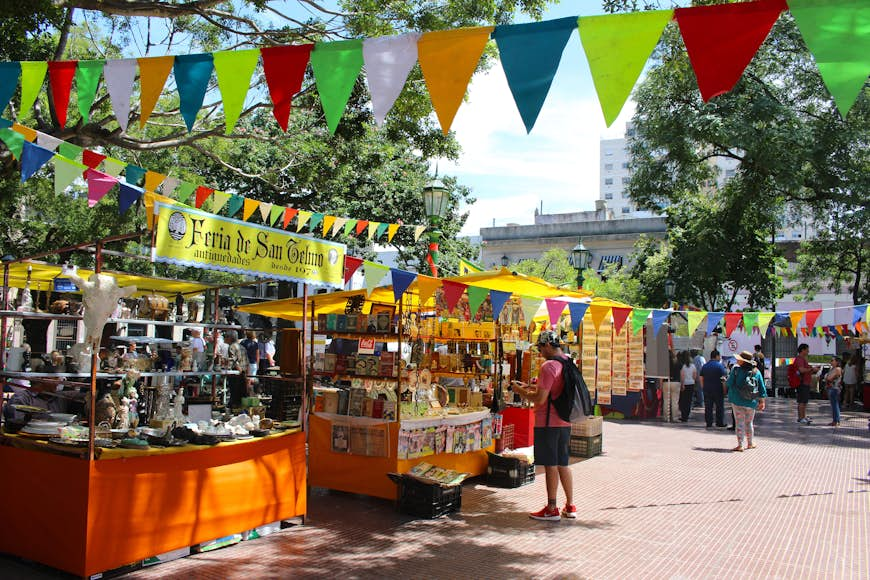
Much of what makes Buenos Aires so magical can be enjoyed for free, including many of the city’s most famous attractions.
From art exhibitions to historical sights to free festivals and concerts, spending a culture-packed day in the city doesn’t have to cost a penny. Strolling the city’s best neighborhoods is an excellent (not to mention most budget-conscious) way to absorb Buenos Aires’ unique charm while admiring spectacular architecture and splashes of stunning street art.
When it’s time for a rest, kick back in one of Buenos Aires’ parks or plazas. You might even catch street performers dancing tango. These top 10 experiences can help you see the best of Buenos Aires without breaking the budget.
Make the most out of every adventure with help from our weekly newsletter delivered to your inbox.
1. Rollerblade and smell the roses in the Bosques de Palermo
In Palermo’s Parque Tres de Febrero (nicknamed the Bosques), the smooth tarmac path that circumnavigates an artificial lake is a popular place to go rollerblading. Bring your own skates and it’s free; otherwise, you can rent a pair near the entrance to the rosedal, the park’s beautiful – and free to visit – rose garden.
2. Immerse yourself in cutting-edge culture at the Usina del Arte
Usina del Arte, a cultural center and events space housed in a magnificent former electricity plant in La Boca, always has something interesting going on. From contemporary dance performances to tango festivals to art exhibitions, the events here are often alternative and rarely mainstream – and nearly always free.
Planning Tip: Look out for kid-friendly activities and workshops, too.
 Admire the elaborate structures in Recoleta Cemetery for free © FotografiaBasica / Getty Images
Admire the elaborate structures in Recoleta Cemetery for free © FotografiaBasica / Getty Images
3. Wander between mausoleums in Recoleta Cemetery
Cementerio de la Recoleta is not your average graveyard. The “streets” of this city of the dead are lined with thousands of elaborate mausoleums in a range of architectural styles – don’t miss the marble, art-nouveau tomb of Rufina Cambaceres.
Most visitors head straight to the tomb of Eva Perón, but be warned, it can be tricky to find.
Planning Tip: Pick up a map at the entrance and allow plenty of time to explore Buenos Aires’ most worthwhile (and free!) attraction.
4. Catch a performance at the Centro Cultural Kirchner
What was once the city’s central post office is now the huge Centro Cultural Kirchner, which offers a range of activities – all for free. Named after President Néstor Kirchner, the CCK has numerous exhibition spaces and several concert halls with outstanding acoustics.
All concerts are free, but you’ll need to get in quick to reserve your tickets. Events often book out just hours after tickets are released.
Planning Tip: The transformation of the building’s interior is remarkable, and if you’re interested in architecture, you should book a free guided tour.
 Enjoy performances in El Caminito for free, but be aware that there may be a charge for photographs © Meinzahn / Getty Images
Enjoy performances in El Caminito for free, but be aware that there may be a charge for photographs © Meinzahn / Getty Images
5. See colorful shacks and street performers on El Caminito
Head to El Caminito, a pedestrianized street in the neighborhood of La Boca, and you’ll find tourists snapping photos of tango dancers in front of brightly painted shacks, looked down on by smiling, cartoonish statues of soccer legend Diego Maradona and tango singer Carlos Gardel. Sure, it might seem a little cheesy, but El Caminito was conceived by local artists as a way of celebrating and preserving the spirit of the neighborhood, and the tenement shacks here are reconstructions of the real colorful homes of port workers.
Visiting El Caminito is free, but street performers may charge for photos.
6. View works of art at the Museo Nacional de Bellas Artes
The vast, free-to-visit Museo Nacional de Bellas Artes is housed in a former waterworks building, now painted pink, in the neighborhood of Recoleta. The collection of some 12,000 works includes pieces by Argentina’s most celebrated artists, such as Benito Quinquela Martín, Xul Solar and Antonio Berni, as well as works by Picasso, Goya, and Renoir.
Planning Tip: Viewing the masterpieces makes a perfect rainy-day activity.
7. Learn about Argentine folk culture at the Feria de Mataderos
To get a taste of traditional Argentinian folk culture head to Feria de Matadero, a free Sunday street fair in the neighborhood of Mataderos on the southwestern outskirts of the city. Browse food and craft stalls and watch musicians perform traditional Argentine folk music, such as Chacareras and Zambas, accompanied by dancing.
Planning Tip: Bring a few pesos for a bowl of locro (corn-based stew) or an empanada or two.
8. Tour the Casa Rosada and look out over Plaza de Mayo
On weekends and public holidays, it’s possible to peek inside Argentina’s famous presidential palace by joining a free guided tour. Guides offer a good overview of the building’s history as the hallowed hallways of the pink house are explored. You’ll even get a chance to step onto the famous balcony for a photo and gaze out over Plaza de Mayo.
Planning Tip: Book tours of the Casa Rosada online. Check the schedule for English language tours if you don’t speak Spanish.
 It’s free to browse at Feria de San Pedro Telmo, a street market held every Sunday © gvictoria / Shutterstock
It’s free to browse at Feria de San Pedro Telmo, a street market held every Sunday © gvictoria / Shutterstock
9. Browse the stalls at the Feria de San Telmo
The Sunday street market in San Telmo extends the length of Calle Defensa, from Plaza Dorrego almost as far as Plaza de Mayo. Browsing the antiques and craft stalls costs nothing (if you can resist the temptation to buy), and street performers provide free entertainment, although it’s good form to throw a few pesos in the hat.
Planning Tip: Check out the nearby Mercado de San Telmo, an atmospheric indoor produce and antiques market.
10. Discover street art in Barracas
Buenos Aires has one of the world’s top street art scenes. You don’t need to venture further than Palermo or San Telmo to see plenty of murals. Within walking distance of Palermo Hollywood, the neighborhoods of Colegiales and Chacarita are rich in street art. Look out for Jim Vision’s depiction of a gaucho on horseback holding a spray can.
The best neighborhood for street art might be Barracas, an off-the-beaten-track area that borders San Telmo and La Boca in the south of the city. Here you’ll find works by artist Martín Ron, and El Regreso de Quinquela, purported to be the longest mural in the world painted by one artist.
Planning Tip: While in Barracas, check out the colorful, mosaic-covered houses of Calle Lanín.



